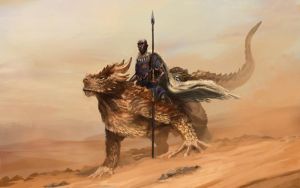Samburru Howler
The 'Samburru Howler,' called Kadal'tongo by certain tribes, is a horned lizard that inhabits the desert. Fully grown, the beast stands at 1.5-2 meters tall, and 6-7 meters from head to tail. It is revered and respected by the natives, as they consider it the sworn enemy of crag-dwelling Manticores. This is not so far from the truth, as the two species have a highly adversarial relationship.
Compared to other ride-able beasts that inhabit Aversia, the Samburru Howler is slow and bulky. It makes up for that otherwise fatal flaw in its ability to climb and jump, allowing it to traverse incredible heights and rugged peaks. When domesticated, it is a prime companion in the mountains, allowing tribesmen and adventurers to traverse otherwise unsurpassable terrain with ease. Though it isn't much of a fighter, its claws, tail, and bite all pose a threat to would-be-attackers.
The long-standing rivalry between Manticores and Kadal'tongo is a result of their preferred habitats. Often seeking the same kinds of conditions, the two animals are forced to compete for dominance. This has resulted in heavy casualties for both species. By virtue of its reptilian origins and hostility towards Manticores, the Howler has developed a resistance to all forms of poison.
Distribution
The Howler is a rare, elusive beast that makes its home in the western mesas, the volcanic mountains that border the eastern desert, and the north-eastern mesas. Spotting one in the dunes is considered a good omen, but this occurrence is almost unheard of.
Habitat
There is no mountain too high nor cliff to sheer for this lizard- it is an excellent climber and a daring free-runner. Samburru Howlers make their home in rocky crags and sandpits, nesting in the higher reaches of the mesas and mountains. They guard these nests very closely, venturing out only to hunt or find water. It is not unusual for them to bask in the sun near their lair, or after a plentiful meal.
Diet
The Kadal'tongo is an omnivorous beast, though its diet is primarily based in roots, fruits, leaves, and cacti. It often uses its horns to scrape away cactus spines and dig at tree roots. On occasion, a hungry Howler will seek out more animated prey- such as arachnids, insects, small mammals, and snakes. To find them, it uses sensory receptors on its long, forked tongue. There are little to no accounts of Howlers feeding on humans, though they may mistake small children for other animals.
Relations
Humanoids can be at ease in the presence of these lizards, as they aren't likely to attack without provocation. The docile lizards hunt and wander on their own, and, once domesticated, make for loyal companions. Despite some of their abilities, they are more commonly used as pack animals and transport than war-beasts.
Though they aren't the most social of reptiles, the Howlers are known to muster together in two distinct situations: first, in the presence of their sworn enemy, the Manticore; second, during mating season, when they must work in tandem to protect their nests. Straying too close to these nests will cause the Kadal'tongo to produce a loud, oscillating noise that stuns predators and alerts nearby lizards of a threat. This is the 'howl' for which they were named.
If a humanoid, animal, or monster ignores their warning, the giant lizards will viciously attack and dismember it. They will leave the carcass of the would-be intruder to be picked at by buzzards and scavengers.
Mechanics
- Docile but highly elusive.
- Indifferent to people in general, but territorial during mating season.
- Capable of climbing mountains, cliffs, and other rock faces.
- Slow compared to other mounts.
- Can perform vertical jumps up to 5 meters.
- Can perform horizontal jumps up to 10 meters.
- Highly aggravated by Manticores.
- Resists all forms of poison.
Material Properties
- The Kadal'tongo's strong, keratin scales can be used in jewelry and armor, whether attached to the hide beneath or not.
- Its claws, interestingly, are an extension of its bones, and famed for their sharpness. They can be shaped into curved, primitive daggers.
- Its teeth, which are rather small, are used in sacred, primitive jewelry.
- Its droppings, once dried out, are excellent kindling for fire.
Alchemical Properties
- A fluid can be extracted from its tongue, but only from a fresh carcass, that heavily bolsters one's sense of smell. To unlock this potential, the fluid must be complimented by ingredients with similar properties.
- Its saliva is extremely potent, and can be used to mask a hunter's scent against other animals. The acrid smell persists for up to two [OOC] days.
| Geography • Races • Flora • Fauna • Stones • Metals • Cloth • Foreign Continents |
| The World of Aethius • The Multiverse of Aethier |
